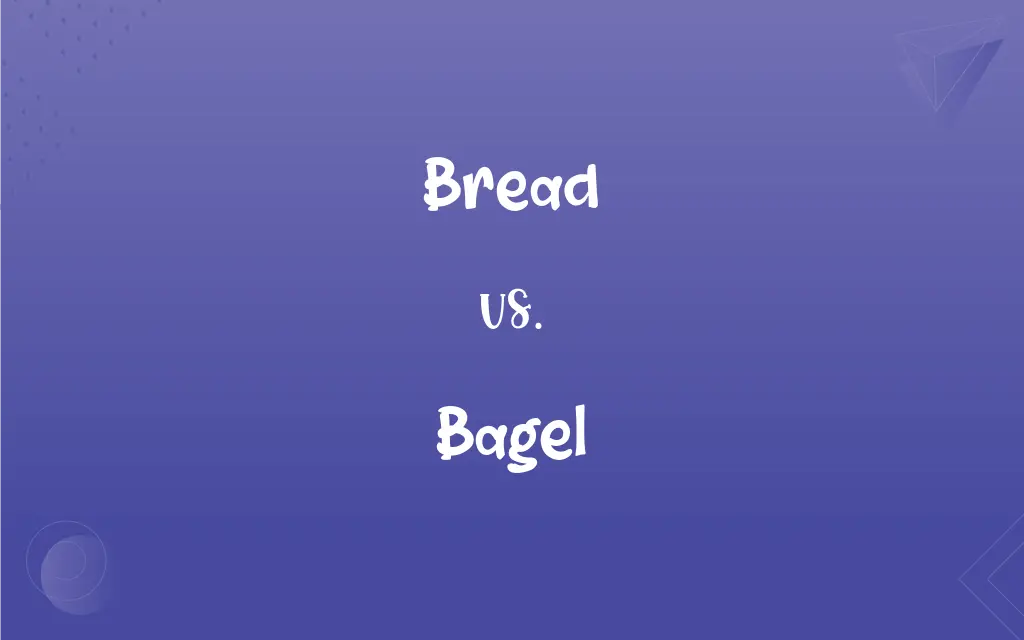Bread vs. Bagel: What's the Difference?
Edited by Aimie Carlson || By Harlon Moss || Updated on October 17, 2023
Bread is a staple food prepared from a dough of flour and water, typically baked; a bagel is a dense, doughnut-shaped bread, often boiled then baked.

Key Differences
Bread is a versatile food that has been a cornerstone of human diet for millennia. It comes in various forms, sizes, and flavors. In contrast, a bagel is a specific type of bread that's recognized by its unique dense texture and ring shape.
The preparation of bread usually involves mixing ingredients like flour, water, salt, and a leavening agent, followed by baking. Bagels, however, have a distinctive preparation process where the dough is first boiled in water before being baked, giving them their characteristic chewy texture.
Bread can be found in countless varieties worldwide, such as sourdough, rye, or multigrain, reflecting the diverse culinary traditions across cultures. Meanwhile, the bagel originated from Jewish communities in Poland and has since become popular globally, often enjoyed with toppings or fillings.
One of the significant differences between bread and bagel is the texture. While breads can range from soft and airy to dense, bagels are consistently dense with a crisp outer crust due to their boiling and baking process.
In terms of consumption, bread is often used for sandwiches, toast, or as a side with meals. In contrast, bagels are popularly sliced, toasted, and spread with cream cheese, butter, or other toppings, making them a favorite breakfast or snack item in many regions.
ADVERTISEMENT
Comparison Chart
Basic Definition
Staple food made from flour and water
Dense, ring-shaped type of bread
Preparation Process
Typically mixed and baked
Boiled then baked
Texture
Varies, can be soft to dense
Consistently dense and chewy
Origin
Worldwide
Jewish communities in Poland
Common Usage
Sandwiches, toast, side dish
Toasted with toppings or fillings
ADVERTISEMENT
Bread and Bagel Definitions
Bread
A product of fermentation using flour and water.
The sourdough bread had a tangy taste due to the fermentation process.
Bagel
A dense, ring-shaped bread, often topped or filled.
She spread cream cheese on her toasted bagel for breakfast.
Bread
A common accompaniment to meals across cultures.
Every meal at her house included a serving of bread.
Bagel
A chewy bread often paired with spreads.
Her favorite bagel topping was a mix of smoked salmon and capers.
Bread
A carbohydrate-rich food, often sliced for sandwiches.
She made a turkey and cheese sandwich using whole wheat bread.
Bagel
A popular breakfast item in many Western countries.
Many New Yorkers start their day with a bagel and coffee.
Bread
A staple food made from baked dough.
She enjoyed the fresh aroma of the newly baked bread.
Bagel
Originating from Jewish culinary traditions.
The bagel has its roots in Jewish communities and is now enjoyed worldwide.
Bread
A term symbolizing basic sustenance or livelihood.
Earning his bread meant he was working for his daily living.
Bagel
A bread product boiled before baking.
The boiling process gives the bagel its unique texture.
Bread
A staple food made from flour or meal mixed with other dry and liquid ingredients, usually combined with a leavening agent, and kneaded, shaped into loaves, and baked.
Bagel
A glazed, ring-shaped roll with a tough, chewy texture, made from plain yeast dough that is dropped briefly into nearly boiling water and then baked.
Bread
Food in general, regarded as necessary for sustaining life
"If bread is the first necessity of life, recreation is a close second" (Edward Bellamy).
Bagel
A toroidal bread roll that is boiled before it is baked.
FAQs
What is bread typically made from?
Bread is usually made from a dough of flour and water, often with added salt and leavening agents.
Are bagels always round?
While traditional bagels are round with a hole in the center, there are some variations without the hole.
Can breads be gluten-free?
Yes, there are gluten-free breads made using alternative flours.
Can bread be made without yeast?
Yes, there are unleavened breads, like flatbreads, made without yeast.
How is a bagel different from regular bread?
A bagel is a dense, ring-shaped bread that's boiled before baking, giving it a distinctive chewy texture.
Can bread be frozen to extend its shelf life?
Yes, freezing bread can help preserve it for longer periods.
Can bagels be used for sandwiches?
Yes, bagels are often sliced and used for various sandwiches.
Is bagel a type of bread?
Yes, a bagel is a specific type of bread with a unique preparation and shape.
Is the bagel's hole functional or decorative?
Originally, the hole helped with even cooking and made it easy to string bagels for selling. It's now mostly traditional.
How long does bread typically last?
Depending on ingredients and storage, a few days to a week. Storing in the fridge may extend this but can affect texture.
Why are bagels often associated with New York?
New York has a rich history of bagel-making, especially within its Jewish communities, making it iconic for its bagels.
Are bagels sweeter than regular bread?
Some bagels have a slight sweetness, but it varies based on the recipe.
Why do bagels sometimes have a shiny surface?
The boiling process and sometimes an egg wash before baking give bagels a shiny crust.
Are there cultural or religious significances to bread?
Yes, bread holds importance in many religious rituals and cultural traditions, like the Jewish Challah or the Christian Eucharist.
Do all bagels have toppings like seeds or salt?
No, while many have toppings, there are also plain bagels.
Is bagel dough different from bread dough?
While similar, bagel dough is often denser and has ingredients like malt for flavor and color.
Why is bread's crust different in texture from its interior?
The crust is exposed directly to the oven's heat, making it harder and darker than the soft interior.
How are sourdough bread and regular bread different?
Sourdough uses natural fermentation and has a distinct tangy flavor, while regular bread often uses commercial yeast.
Why is bread a staple in many diets?
Bread is versatile, filling, and can be easily paired with many foods, making it a dietary staple.
What's the difference between white bread and whole wheat bread?
White bread is made from refined flour, while whole wheat uses the entire grain, offering more fiber.
About Author
Written by
Harlon MossHarlon is a seasoned quality moderator and accomplished content writer for Difference Wiki. An alumnus of the prestigious University of California, he earned his degree in Computer Science. Leveraging his academic background, Harlon brings a meticulous and informed perspective to his work, ensuring content accuracy and excellence.
Edited by
Aimie CarlsonAimie Carlson, holding a master's degree in English literature, is a fervent English language enthusiast. She lends her writing talents to Difference Wiki, a prominent website that specializes in comparisons, offering readers insightful analyses that both captivate and inform.































































